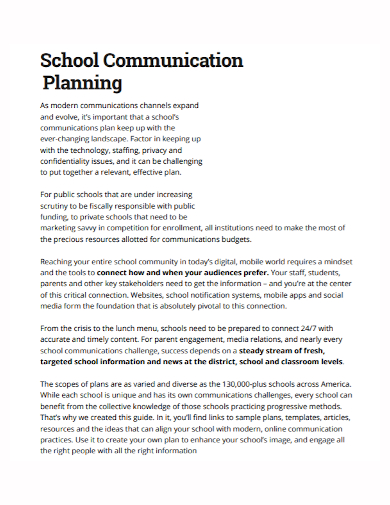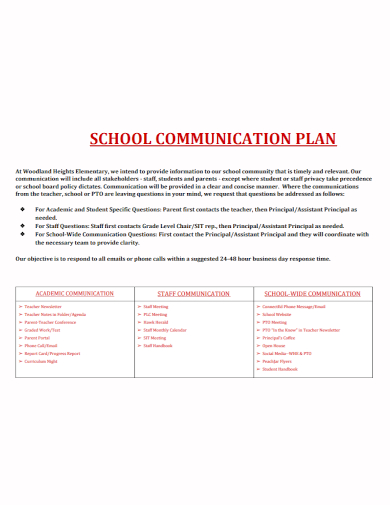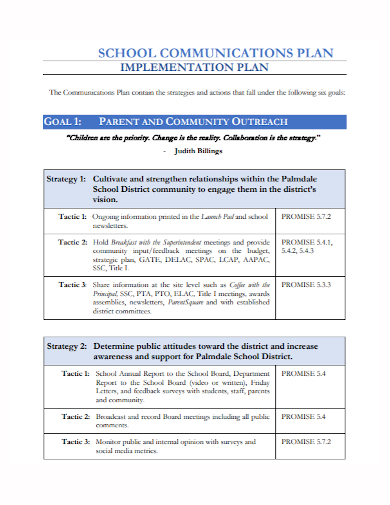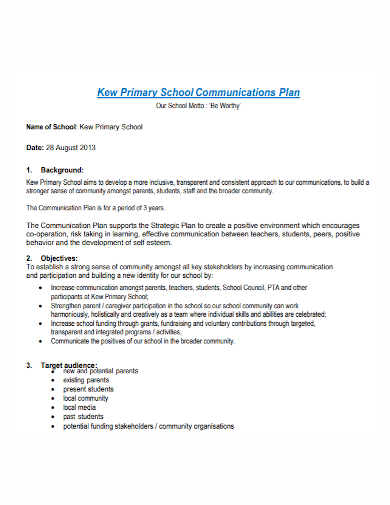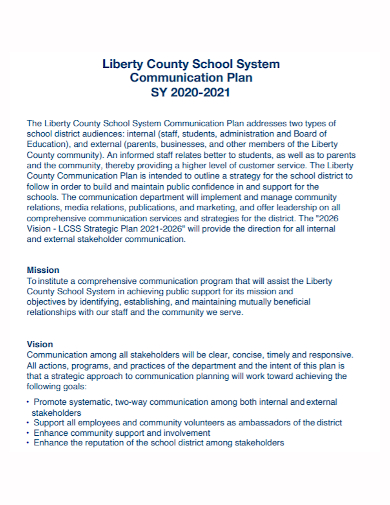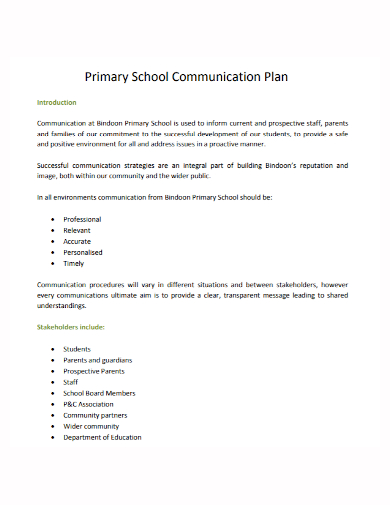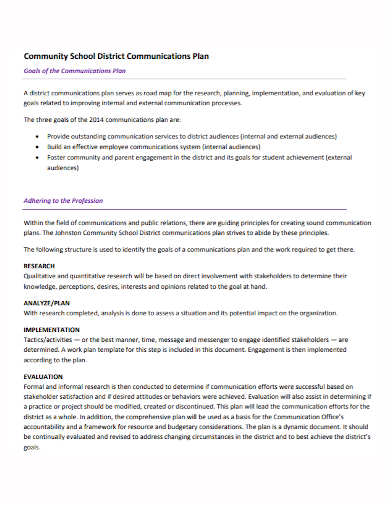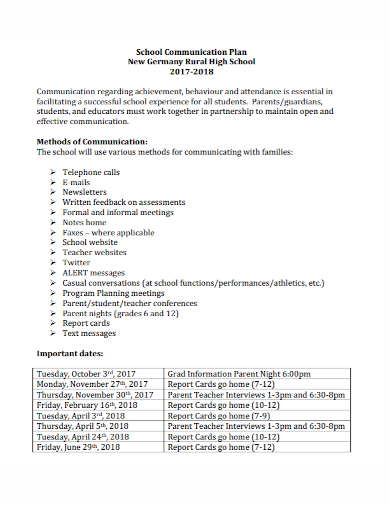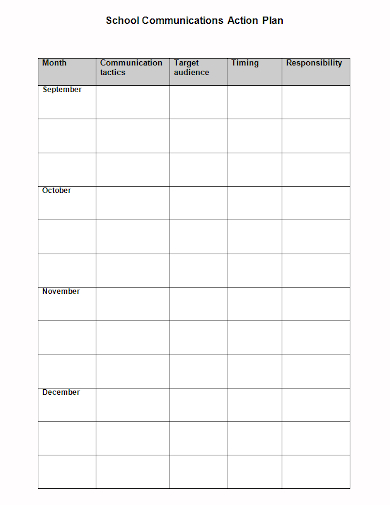Is your school struggling to effectively communicate with your students, their parents, and your own staff? Have you encountered troubles on addressing your message and are met with backlash or more questions about it? Is your inefficiency in communicating well with your audience is making your school’s brand and reputation to suffer? Maybe you need to sit it down and create a communication plan to remedy these concerns. A communication plan defines who needs to be aware of what information they need to know and how and how often that specific information will be distributed, and who will be responsible for the distribution. Making it is not as complicated as it sounds as long you understand the fundamentals of how communication works. Read the article to know how to make a school communication plan.
10+ School Communication Plan Samples
1. School Communication Plan Template
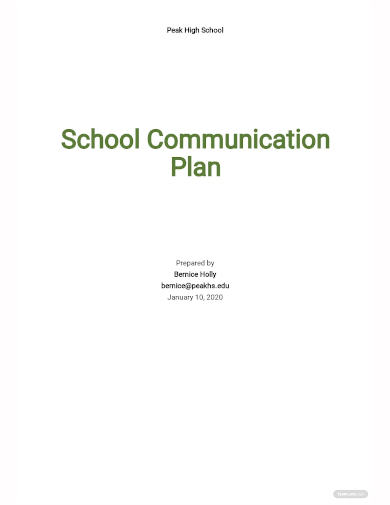
2. School Communication Plan
3. Sample School Communication Plan
4. School Communication Implementation Plan
5. Primary School Communication Plan
6. School System Communication Plan
7. School District Communication Plan
8. Standard School Communication Plan
9. Community School Communication Plan
10. High School Communication Plan
11. School Communication Action Plan
What is a Communication Plan?
A communication plan is an approach done by institutions, businesses, and organization to provide their stakeholders with information regarding how to effectively connect through messages to their key audience. It also outlines who should be given the specific information (usually confidential or sensitive information), when that information will be delivered, what channels will be used to deliver the information (is it communicated with the use of emails, websites, or printed reports?), what channels will the stakeholders use to give their feedback, and how the communication is documented.
How to Create a School Communication Plan
1. Know your mission
Examine the strengths and disadvantages of your school. What factors will influence the students’ parents’ decisions to send their children to your school? Create a school mission based on well-researched information from school administrators as well as what you know about your school and your goals of where you envision it to be.
2. Know Your Target Audiences
You should also think about how you communicate with your staff, parents, and students right now. Are there any gaps that need to be filled? Have there been any miscommunications between staff and parents because the information isn’t being communicated as effectively as it could be? How can you improve staff, parent, and student engagement in your school?
Surveys are a wonderful approach to collect information on the concerns from school staff, parents, and students for you to address them. This will help you create your communications plan around your target groups with whom you need to communicate more effectively.
3. Use Key Communication Channels to Reach Your Audiences
It all boils down to picking the appropriate medium to communicate with your target audience. Know first your target audience’s location, and how you can get in touch with them. A school website and social media accounts are excellent tools to communicate with staff, parents, and students.
These are the must-have communication channels to include in your plan:
- District and school websites
- Mobile applications
- Notifications and alerts
- Social media
- Blog
- Video
- Podcasts
These are crucial for reaching out to all of your stakeholders. Combining all of these channels might be difficult, but they must be integrated for maximum reach.
3. Plan and Gather the Correct Content with the Help of a Team and Technology
Once you’ve made your decision, it’s time to develop your message when you’ve decided how you’ll engage your target audiences. What do you want your audience to take away from this? How can you best use these channels to engage them and encourage them to return to them? Who will do all of the legwork in terms of locating and creating all of the content?
Surround yourself with communications lieutenants who can act as eyes and ears for the huge ‘field’ of building-level communication possibilities. Principals, administrators, teachers, or any other staff member who can serve as an advocate for school communications can be named as designees.
The four most important subject areas to cover are:
- Crisis communication
- Internal communications
- Media and public relations
- Parental involvement
FAQs
What are the seven C’s of communication?
The seven C’s of communications are: clarity, correctness, conciseness, courtesy, concreteness, consideration, and completeness.
What are the four S’s of communication?
The four S’s of making a good and effective communication are shortness, simplicity, strength, and sincerity.
The steps mentioned aboveon how to make an efficient communication plan will hopefully will get you on the right direction of effectively communicating with your target audience by improving your engagement with them and put your school’s best on going forward. should get you pointed in the right direction. To help you get started making the plan, download our free sample templates above to use as your guide!
Related Posts
FREE 8+ Debt Management Plan Samples in PDF | DOC
FREE 10+ Sales Management Plan Samples in PDF | MS Word | Apple Pages | Google Docs
FREE 4+ 30-60-90-Day Marketing Plan Samples in MS Word | Google Docs | Apple Pages | PDF
FREE 10+ Higher Education Lesson Plan Samples in MS Word | Pages | Google Docs | PDF
FREE 9+ 30-Day Marketing Plan Samples in PDF | MS Word | Apple Pages | Google Docs
FREE 3+ Sales Team Action Plan Samples in PDF | MS Word | Apple Pages | Google Docs
Marketing Plan For Small Business Samples
FREE 7+ Fashion Business Plan Samples in PDF
FREE 10+ Sprint Planning Samples In MS Word | Google Docs | PDF
FREE 10+ Wedding Planning Samples in MS Word | Apple Pages | Powerpoint | PDF
FREE 9+ Monthly Study Planner Samples in PSD | Illustrator | InDesign | PDF
FREE 9+ Sample Curriculum Planning Templates in PDF | MS Word
FREE 10+ Teacher Development Plan Samples in MS Word | Google Docs | Apple Pages | PDF
FREE 10+ Basketball Practice Plan Samples in PDF
FREE 12+ School Business Plan Samples in PDF | MS Word | Apple Pages | Google Docs

